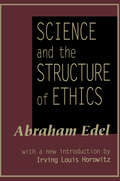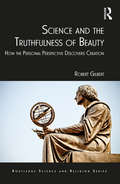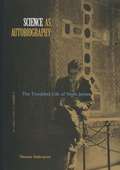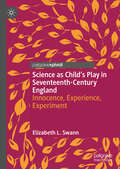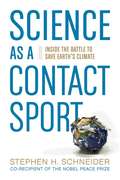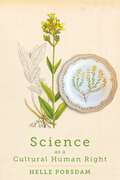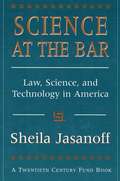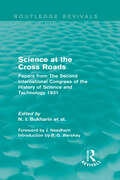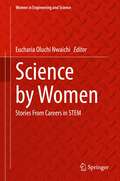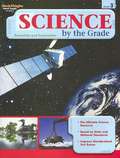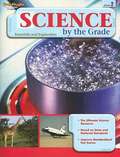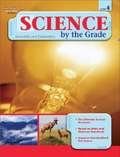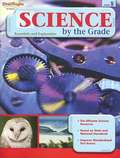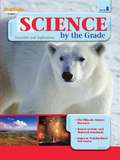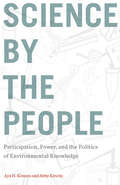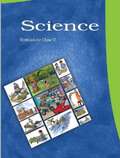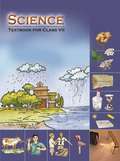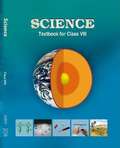- Table View
- List View
Science and the Structure of Ethics
by Abraham EdelInitially prepared as part of the Foundations of the Unity of Science volumes under the auspices of the International Encyclopedia of Unified Science, Science and the Structure of Ethics soon took on a life of its own. Well positioned in the naturalistic tradition of ethical theory extending from John Dewey at the start and Richard Rorty at the conclusion of the century, Abraham Edel's volume offers a remarkable synthesis of the ways hi which ethical statements can be examined, and the nature of ethical concerns.Edel reveals a singular capacity to move beyond oracular controversies of the good and the right hi favor of a comparative, analytic, and functional account of how ethical perspectives and practices affect the content of moral discourse. In Edel's work, the structure of ethical behavior is defined by biological, psychological, social, and historical functions. Hence a scientific account of ethics is possible since moral norms are themselves products of an experiential field open to verification procedures common to all other walks of human life.In reviewing the impact of Edel's work hi general, and this volume in particular, Irving Louis Horowitz notes that Edel's naturalistic emphasis fits neatly with a view of ethics as something grounded in human experience rather than mandated from divine assumption: "It is hard for me to imagine a turning back from the hard lessons of the century, any more in ethical theory than in empirical research as such. We owe a central place in our century's intellectual capital to Edel's examination of ethical doctrines in the light of changing circumstances." This is a work certain to enlist the interest of ethicists, sociologists of knowledge, as well as those concerned with issues hi the philosophy of science and religion alike.
Science and the Trinity: The Christian Encounter with Reality
by John C. PolkinghorneMost often, the dialogue between religion and science is initiated by the discoveries of modern science--big bang cosmology, evolution, or quantum theory, for example. In this book, scientist-theologian John Polkinghorne changes the discussion. He approaches the dialogue from a little-explored perspective in which theology shapes the argument and sets the agenda of questions to be considered. The author begins with a review of approaches to science and religion in which the classification focuses on theological content rather than on methodological technique. He then proceeds with chapters discussing the role of Scripture, a theology of nature, the doctrine of God, sacramental theology, and eschatology. Throughout, Polkinghorne takes the perspective of Trinitarian thinking while arguing in a style that reflects the influence of his career as a theoretical physicist. In the final chapter, the author defends the appropriateness of addressing issues of science and religion from the specific standpoint of his Christian belief. His book provides an important model for theologians and scientists alike, showing how their two fields can inform one another in significant ways.
Science and the Truthfulness of Beauty: How the Personal Perspective Discovers Creation (Routledge Science and Religion Series)
by Robert GilbertWhen scientists describe their results or insights as 'beautiful', are they using the term differently from when they use it of a landscape, music or another person? Science and the Truthfulness of Beauty re-examines the way in which seeing beauty in the world plays the key role in scientific advances, and argues that the reliance on such a personal point of view is ultimately justified by belief that we are made in the 'image of God', as Christian and Jewish believers assert. It brings a fresh voice to the ongoing debate about faith and science, and suggests that scientists have as much explaining to do as believers when it comes to the ways they reach their conclusions.
Science as Autobiography: The Troubled Life of Niels Jerne
by Thomas Soderqvist Niels Kaj Jerne David Mel PaulThis biography probes the unusual mind, the dramatic life, and the outstanding scientific work of Danish-born immunologist Niels Jerne (1911-1994). Jerne's Nobel Prize-winning achievements in the field of immunology place him in the pantheon of great twentieth-century biomedical theorists, yet his life is perhaps even more interesting than his science. Science as Autobiography tells Jerne's story, weaving together a narrative of his experiences, emotional life, and scientific work, and arguing that the source of Jerne's extraordinary creativity as a scientist rested in his life story. Drawing on Jerne's own extensive archives, on more than 150 hours of conversation with him, and on the recollections of over 90 friends, colleagues, and relatives, Thomas Soderqvist explores the myths and legends about Jerne - his unparalleled powers of concentration and analytical keenness, his preference for conversation in a Paris cafe over work in the laboratory, his problematic personal life, Soderqvist punctuates the book with Jerne's own voice and makes the argument that Jerne's life experience and view of himself became a metaphorical resource for the construction of his theories. The author also probes the moral issues that surrounded Jerne's choice to sacrifice the welfare of his family in favor of scientific goals and the pursuit of excellence. --BOOK JACKET. Title Summary field provided by Blackwell North America, Inc. All Rights Reserved
Science as Child’s Play in Seventeenth-Century England: Innocence, Experience, Experiment
by Elizabeth L. SwannIn recent decades, scholars have uncovered the vital contributions made by non-elite figures, including women, artisans, and indigenous peoples, to the development of early modern natural philosophy. This Palgrave Pivot argues that children, too, quite literally played a decisive role in seventeenth-century experimental science in England, both as rhetorical exemplars, and as active contributors in the generation of natural knowledge. Exploring a widespread but critically-neglected connection between experiment and child’s play, it both illuminates the extent to which children participated – intentionally or incidentally – in natural historical and experimental activities, and investigates how ideas about childish innocence and sensory receptivity informed the nascent ideology of scientific objectivity. In the work of figures associated with the early Royal Society, this book proposes, children emerge as instinctive empiricists and experimenters, setting in motion a broader cultural transformation in ideas about childhood and education which still shapes how we think about these things today.
Science as Psychology
by Lisa M. Osbeck Nancy J. Nersessian Kareen R. Malone Wendy C. NewstetterScience as Psychology reveals the complexity and richness of rationality by demonstrating how social relationships, emotion, culture and identity, are implicated in the problem-solving practices of laboratory scientists. The authors gather and analyze interview and observational data from innovation-focused laboratories in the engineering sciences to show how the complex practices of laboratory research scientists provide rich psychological insights, and how a better understanding of science practice facilitates understanding of human beings more generally. The study focuses not on dismantling the rational core of scientific practice, but on illustrating how social, personal and cognitive processes are intricately woven together in scientific thinking. The authors argue that this characterization addresses the integration problem in science studies - how to characterize the fluid entanglements of cognitive, affective, material, cultural and other dimensions of discovery and problem solving. The book is thus a contribution to science studies, the psychology of science and general psychology.
Science as a Contact Sport: Inside the Battle to Save Earth's Climate
by Stephen H. SchneiderSchneider persuasively outlines a plan to avert the building threat and develop a positive, practical policy that will bring climate change back under our control, help the economy with a new generation of green energy jobs and productivity, and reduce the dependence on unreliable exporters of oil, and thus ensure a future for ourselves and our planet that's as rich with promise as our past.
Science as a Cultural Human Right (Pennsylvania Studies in Human Rights)
by Helle PorsdamThe human right to science, outlined in the 1948 Universal Declaration of Human Rights and repeated in the 1966 International Covenant on Economic, Social, and Cultural Rights, recognizes everyone’s right to “share in scientific advancement and its benefits” and to “enjoy the benefits of scientific progress and its applications.” This right also requires state parties to develop and disseminate science, to respect the freedom of scientific research, and to recognize the benefits of international contacts and co-operation in the scientific field.The right to science has never been more important. Even before the COVID-19 health crisis, it was evident that people around the world increasingly rely on science and technology in almost every sphere of their lives from the development of medicines and the treatment of diseases, to transport, agriculture, and the facilitation of global communication. At the same time, however, the value of science has been under attack, with some raising alarm at the emergence of “post-truth” societies. “Dual use” and unintended, because often unforeseen, consequences of emerging technologies are also perceived to be a serious risk.The important role played by science and technology and the potential for dual use makes it imperative to evaluate scientific research and its products not only on their scientific but also on their human rights merits. In Science as a Cultural Human Right, Helle Porsdam argues robustly for the role of the right to science now and in the future. The book analyzes the legal stature of this right, the potential consequences of not establishing it as fundamental, and its connection to global cultural rights. It offers the basis for defending the free and responsible practice of science and ensuring that its benefits are spread globally.
Science at Sea
by Jeffrey Fuerst Jeanette LeardiNearly three-quarters of our planet is water, but we have studied only a very small part of the world's oceans. How do scientists do research beneath the sea? (Set of 6 with Common Core Editions of Teacher Materials)
Science at the Bar: Law, Science, and Technology in America (Twentieth Century Fund Books/Reports/Studies #9)
by Sheila JasanoffIssues spawned by the headlong pace of developments in science and technology fill the courts. How should we deal with frozen embryos and leaky implants, dangerous chemicals, DNA fingerprints, and genetically engineered animals? The realm of the law, to which beleaguered people look for answers, is sometimes at a loss--constrained by its own assumptions and practices, Sheila Jasanoff suggests. This book exposes American law's long-standing involvement in constructing, propagating, and perpetuating a variety of myths about science and technology. Science at the Bar is the first book to examine in detail how two powerful American institutions--both seekers after truth--interact with each other. Looking at cases involving product liability, medical malpractice, toxic torts, genetic engineering, and life and death, Jasanoff argues that the courts do not simply depend on scientific findings for guidance--they actually influence the production of science and technology at many different levels. Research is conducted and interpreted to answer legal questions. Experts are selected to be credible on the witness stand. Products are redesigned to reduce the risk of lawsuits. At the same time the courts emerge here as democratizing agents in disputes over the control and deployment of new technologies, advancing and sustaining a public dialogue about the limits of expertise. Jasanoff shows how positivistic views of science and the law often prevent courts from realizing their full potential as centers for a progressive critique of science and technology. With its lucid analysis of both scientific and legal modes of reasoning, and its recommendations for scholars and policymakers, this book will be an indispensable resource for anyone who hopes to understand the changing configurations of science, technology, and the law in our litigious society.
Science at the Cross Roads: Papers from The Second International Congress of the History of Science and Technology 1931 (Routledge Revivals)
by N. I. Bukharin et alThe papers given by the Soviet Delegation to the Second International Congress of the History of Science and Technology in London in 1931, headed by N. I. Bukharin, exerted a profound influence on Western historiography of science. Perhaps the most influential contribution was that of Hessen, who made a long and classical statement of Marxist historiography, taking Isaac Newton as his example. The collection, which appeared in Britain at the height of the Depression, fostered an acute social awareness and a heated debate among many working scientists. Accredited by some as "the starting point of a new evaluation of the history of science", the book reflects the huge social and economic divide between Socialism and Capitalism present at the time of publication, and its influence on intellectual culture and scientific advancement.
Science between Europe and Asia
by Feza Günergun Dhruv RainaThis book explores the various historical and cultural aspects of scientific, medical and technical exchanges that occurred between central Europe and Asia. A number of papers investigate the printing, gunpowder, guncasting, shipbuilding, metallurgical and drilling technologies while others deal with mapping techniques, the adoption of written calculation and mechanical clocks as well as the use of medical techniques such as pulse taking and electrotherapy. While human mobility played a significant role in the exchange of knowledge, translating European books into local languages helped the introduction of new knowledge in mathematical, physical and natural sciences from central Europe to its periphery and to the Middle East and Asian cultures. The book argues that the process of transmission of knowledge whether theoretical or practical was not a simple and one-way process from the donor to the receiver as it is often admitted, but a multi-dimensional and complex cultural process of selection and transformation where ancient scientific and local traditions and elements. The book explores the issue from a different geopolitical perspective, namely not focusing on a singular recipient and several points of distribution, namely the metropolitan centres of science, medicine, and technology, but on regions that are both recipients and distributors and provides new perspectives based on newly investigated material for historical studies on the cross scientific exchanges between different parts of the world.
Science by Women: Stories From Careers in STEM (Women in Engineering and Science)
by Eucharia Oluchi NwaichiThis book provides a roadmap for those embarking on a career in STEM, whether in the research or industry realms. Focusing on paths taken by women, the contributors lend their stories, tips and tricks, and hardships they faced entering into fields historically dominated by men. The authors provide practical advice, highlighting soft skills that are not often taught as modules in the classroom. Topics include research collaborations, performance enhancement, the gender lens in research design and development, imposter syndrome felt by many women in science, ethics in science, scaling feminine leadership, being an influencer as a science leader, and time and resources optimization for career advancement in science from resource-poor settings. Others interested in science and its impacts on society will also find the book informative and timely. As an important part of the Organization for Women in Science in the Developing World (OWSD), University of Port Harcourt Branch Book project, the work hopes to inspire women and men, girls and boys to enter and apply themselves to secure the future in STEM.
Science by the Grade Essentials and Exploration: Grade 3
by Harcourt AchieveScience textbook for Grade 3
Science by the Grade: Essentials and Exploration, Grade 2
by Steck-VaughnThe contents of this book are based upon the National Science Education Standards for Grade 2. These standards include (A) Science as Inquiry, (B) Physical Science, (C) Life Science, (D) Earth and Space Science, (E) Science and Technology, (F) Science in Personal and Social Perspectives, and (G) History and Nature of Science. This book will help teachers, students, parents, and tutors. Teachers can use this book either to introduce or review a topic in their science classroom. Students will find the book useful in reviewing the major concepts in science. Parents can use this book to help their children with topics that may be posing a problem in the classroom. Tutors can use this book as a basis for their lessons and for assigning questions and activities. This book includes ten lessons that focus on the ten major concepts presented in the content standards: Physical Science, Life Science, and Earth and Space Science. The lessons also cover the twelve major concepts presented in the other standards. A table on page 4 provides a correlation between the contents of each lesson and the National Science Education Standards.
Science by the Grade: Essentials and Exploration, Grade 4
by Steck-VaughnThe contents of this book are based upon the National Science Education Standards for Grade 4. These standards include (A) Science as Inquiry, (B) Physical Science, (C) Life Science, (D) Earth and Space Science, (E) Science and Technology, (F) Science in Personal and Social Perspectives, and (G) History and Nature of Science. This book will help teachers, students, parents, and tutors. Teachers can use this book either to introduce or review a topic in their science classroom. Students will find the book useful in reviewing the major concepts in science. Parents can use this book to help their children with topics that may be posing a problem in the classroom. Tutors can use this book as a basis for their lessons and for assigning questions and activities. This book includes ten lessons that focus on the ten major concepts presented in the content standards: Physical Science, Life Science, and Earth and Space Science. The lessons also cover the twelve major concepts presented in the other standards. A table on page 4 provides a correlation between the contents of each lesson and the National Science Education Standards.
Science by the Grade: Essentials and Exploration, Grade 5
by Steck-VaughnThe contents of this book are based upon the National Science Education Standards for Grade 5. These standards include (A) Science as Inquiry, (B) Physical Science, (C) Life Science, (D) Earth and Space Science, (E) Science and Technology, (F) Science in Personal and Social Perspectives, and (G) History and Nature of Science. This book will help teachers, students, parents, and tutors. Teachers can use this book either to introduce or review a topic in their science classroom. Students will find the book useful in reviewing the major concepts in science. Parents can use this book to help their children with topics that may be posing a problem in the classroom. Tutors can use this book as a basis for their lessons and for assigning questions and activities. This book includes ten lessons that focus on the ten major concepts presented in the content standards: Physical Science, Life Science, and Earth and Space Science. The lessons also cover the twelve major concepts presented in the other standards. A table on page 4 provides a correlation between the contents of each lesson and the National Science Education Standards.
Science by the Grade: Essentials and Exploration, Grade 8
by Steck-VaughnThe contents of this book are based upon the National Science Education Standards for Grade 8. These standards include (A) Science as Inquiry, (B) Physical Science, (C) Life Science, (D) Earth and Space Science, (E) Science and Technology, (F) Science in Personal and Social Perspectives, and (G) History and Nature of Science. This book will help teachers, students, parents, and tutors. Teachers can use this book either to introduce or review a topic in their science classroom. Students will find the book useful in reviewing the major concepts in science. Parents can use this book to help their children with topics that may be posing a problem in the classroom. Tutors can use this book as a basis for their lessons and for assigning questions and activities. This book includes ten lessons that focus on the ten major concepts presented in the content standards: Physical Science, Life Science, and Earth and Space Science. The lessons also cover the twelve major concepts presented in the other standards. A table on page 4 provides a correlation between the contents of each lesson and the National Science Education Standards.
Science by the People: Participation, Power, and the Politics of Environmental Knowledge (Nature, Society, and Culture)
by Aya H. Kimura Abby KinchyCitizen science—research involving nonprofessionals in the research process—has attracted both strong enthusiasts and detractors. Many environmental professionals, activists, and scholars consider citizen science part of their toolkit for addressing environmental challenges. Critics, however, contend that it represents a corporate takeover of scientific priorities. In this timely book, two sociologists move beyond this binary debate by analyzing the tensions and dilemmas that citizen science projects commonly face. Key lessons are drawn from case studies where citizen scientists have investigated the impact of shale oil and gas, nuclear power, and genetically engineered crops. These studies show that diverse citizen science projects face shared dilemmas relating to austerity pressures, presumed boundaries between science and activism, and difficulties moving between scales of environmental problems. By unpacking the politics of citizen science, this book aims to help people negotiate a complex political landscape and choose paths moving toward social change and environmental sustainability.
Science class 10 - Meghalaya Board
by Meghalaya Board of School EducationPublished by the Meghalaya Boad of School Education for Class X, this is a textbook in science and is made according to the latest syllabus pattern set by the CBSE board. It contains topics from the standard syllabus such as chemical reactions and equations, metals and non-metals, acids, bases, and salts, carbon, the periodic table, life processes, reproduction, heredity, light, electricity, the human eye, energy, magnetism, the environment, and resource management. In order to make learning easier, the books are furnished with illustrations that convey clear-cut ideas to students. Similarly, the examples provided in the book are well described and help in clearing any confusions that may arise. The book also comes with solved and unsolved questions so that students can test themselves, and improve their skills.
Science class 10 - NCERT - 23
by National Council of Educational Research and TrainingThe "Science Textbook for Class X" by NCERT provides a comprehensive overview of essential scientific concepts catered to the tenth-grade level in the Indian education system. The textbook is meticulously structured, covering diverse areas of science, including physics, chemistry, and biology. Students are introduced to concepts like electricity, magnetic effects of electric current, and sources of energy in physics. In chemistry, the book delves into topics such as chemical reactions, acids, bases, metals, and non-metals. The biology section explores the intricate facets of life processes, reproduction, heredity, and evolution. Alongside theoretical content, the book incorporates practical applications, real-world examples, and experimental procedures, fostering an experimental and inquiry-based learning approach. Diagrams, illustrations, and exercises further enhance understanding and retention. By the end of this textbook, students gain a robust foundation in core scientific principles, preparing them for advanced studies and real-world scientific applications.
Science class 6 - NCERT - 23
by National Council of Educational Research and TrainingThe Class VI Science textbook published by NCERT (National Council of Educational Research and Training) is a comprehensive guide designed to introduce young learners to the fundamentals of science. The book is structured in a manner that fosters an understanding of basic scientific principles through engaging text and vivid illustrations. It covers various topics such as food, components of food, fibers, sorting materials into groups, living organisms and their surroundings, body movements, light, shadows and reflection, electricity and circuits, fun with magnets, water, air, garbage in, garbage out, among others. Each chapter is meticulously curated to encourage interactive learning, with thought-provoking exercises, activities, and experiments that enable students to apply their knowledge practically. The textbook aims to kindle curiosity and critical thinking, fostering a scientific temper among students while promoting an appreciation for the world around them. It aligns with the NCERT curriculum, providing a solid foundation in science and encouraging students to explore the subject with enthusiasm and inquisitiveness.
Science class 7 - NCERT - 23
by National Council of Educational Research and Training"Science Class 7 by NCERT offers an enchanting voyage into the wonders of the natural world. Delving into the secrets of plant nutrition, animal digestion, and the nuances of heat transfer, the curriculum sparks curiosity. Chemistry comes alive as students explore the realms of acids, bases, and salts, witnessing captivating transformations during physical and chemical changes. The intricate networks that transport nutrients within organisms are unveiled, along with the fascinating mechanisms of plant reproduction. Chapters on motion, time, electricity, and light weave a tapestry of scientific marvels, engaging learners with activities and experiments. The importance of forests in our lives is emphasized, underscoring their crucial role in sustaining our planet. Concluding with a focus on wastewater, students discover the significance of responsible treatment for a healthier Earth. With vibrant illustrations and hands-on experiences, Science Class 7 by NCERT promises a mind-blowing exploration, inviting students to marvel at the astonishing intricacies of the world around them."
Science class 8 - NCERT - 23
by National Council of Educational Research and TrainingThe NCERT Class 8 Science textbook provides a comprehensive overview of key scientific concepts and principles designed to engage and educate students at the middle school level. Divided into several chapters covering topics such as Crop Production and Management, Microorganisms, Synthetic Fibers and Plastics, and Conservation of Plants and Animals, the textbook delves into fundamental scientific principles with clarity and depth. Through a combination of informative text, colorful illustrations, and hands-on activities, students are encouraged to develop a deeper understanding of various scientific phenomena and their real-world applications. Additionally, the textbook emphasizes critical thinking and problem-solving skills, fostering a holistic approach to scientific inquiry and exploration. With its structured curriculum and accessible language, the NCERT Class 8 Science textbook serves as an invaluable resource for students seeking to develop a strong foundation in science.
Science class 8 - Tamil Nadu Board
by State Council of Educational Research and TrainingThe textbook underscores the critical role of measurement in scientific inquiry and everyday life, introducing various unit systems such as FPS, CGS, and MKS, while emphasizing the International System of Units (SI). It elaborates on the seven base quantities—length, mass, time, temperature, electric current, amount of substance, and luminous intensity—and their respective SI units. The text further explains temperature as a measure of average kinetic energy and electric current as the flow of electric charges, detailing their units and measurement methods. Additionally, it covers derived quantities like plane angle and solid angle, describing their definitions and units. Through activities and practical examples, the textbook aims to deepen students' grasp of fundamental scientific concepts.
